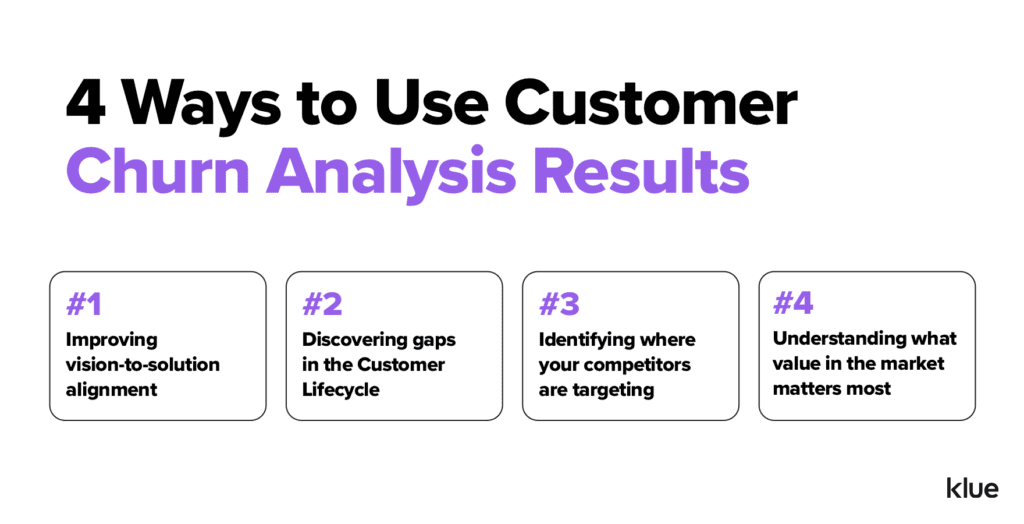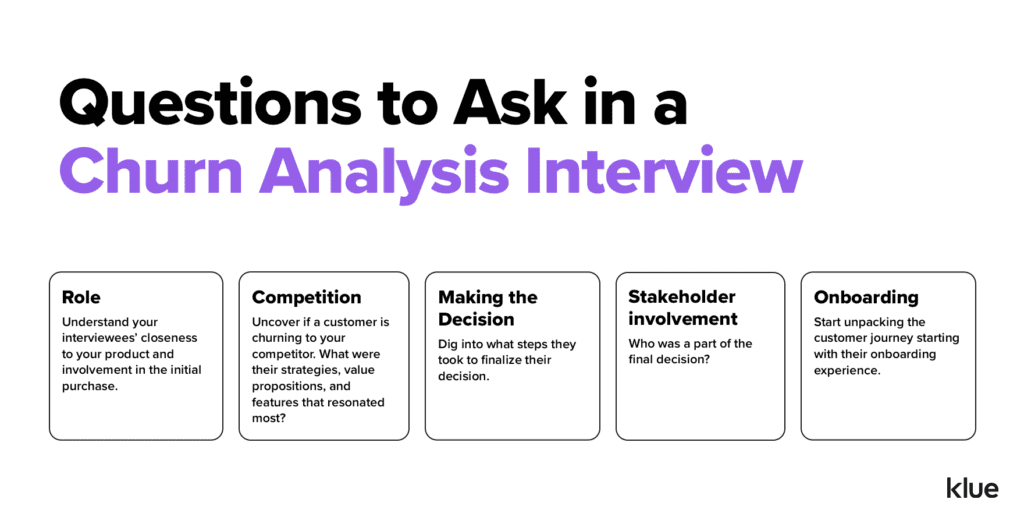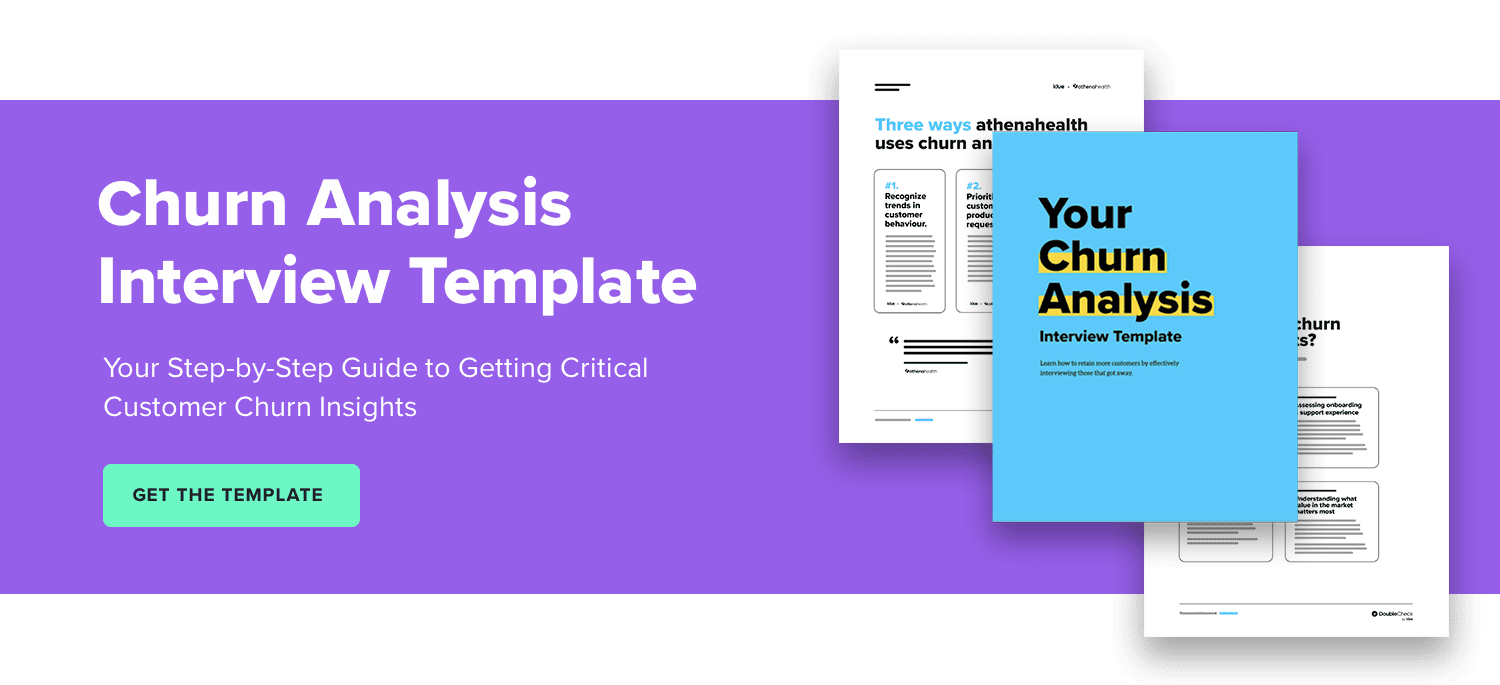Klue Compete
The Competitive Enablement Platform
Learn More
FIND OUT MORE >

Keeping customers has never been more critical for businesses. One of the best ways to do so is by learning from the ones that have left you.
Enter customer churn analysis.
In this article, we’ll dive into what customer churn analysis is, the business decisions your churn analysis results can inform, and best practices for conducting your own churn interviews.
Churn analysis is a way for businesses to understand customer behavior and address potential customer retention issues before they become a problem.
Businesses identify patterns of behaviour for customers leaving through both quantitative analysis and qualitative research. From there, they can make informed decisions from these patterns to reduce customer churn and improve customer experience.
Haven’t run churn analysis before? No problem, follow the steps in our churn analysis interview template here.



Before we get into how to conduct churn analysis, it’s important to know what we’re looking to learn first. Here are four ways businesses use churn analysis results.


When there was less budget oversight on deals, it was easier for businesses to bring in customers that weren’t a perfect match. Now, the ramifications of bringing in those non-ideal customers start to hit.
Use churn analysis to clarify what customers are actually the best fit for your business, and enable your revenue teams to be more efficient in who they sell, and upsell, to.
Competitors are always lurking, long after a deal closes.
When they’re able to nab your customer, it’s a double blow to your morale and your bottom line. Use churn analysis to identify the strategies, value propositions, and features they’re leaning into to take business from you. Don’t overlook churn interviews as a source of competitive intelligence.
You know us, we love our win-loss analysis.
But only churn interviews provide insight into the key stages of your customer’s lifecycle, like onboarding, implementation, adoption, expansion, and renewal.
Dig into the areas where you can improve your customers’ time-to-value. The quicker they see the value, the healthier the customer.
Unpack what value means to your customers. Identify the things that would’ve kept them as a customer, whether it’s product enhancements around a specific use case or greater onboarding support.
When budgets are tight, businesses have to prioritize the areas of value that customers are most willing to pay for.
Conducting quantitative and qualitative churn analysis is essential to gain a comprehensive understanding of customer behavior.
Quantitative churn analysis looks at hard data such as customer usage patterns, purchase history, lifetime value, and other metrics to identify customers at risk of leaving.
However, qualitative churn analysis examines the underlying trends for customer churn through in-depth interviews. It adds colour and context to the data collected.
Here’s a pro tip that you need to know when heading into churn interviews: You’re going to hear about price pretty much every time you run a churn interview. Price is a valid reason, but it’s rarely the only reason. Think:
Price will come up. But don’t stop there. Keep digging.
Our DoubleCheck by Klue experts typically dives into 12 key categories when asking conducting churn analysis interview questions. Here are a few must-haves to include:


If you want to know the other 7 categories and questions our experts ask in each category, then check out our Churn Analysis Interview Template.



athenahealth brought the DoubleCheck by Klue team in to support churn analysis. Here’s how they used the insights gathered:
1. Recognize trends in customer behaviour.
athenahealth has a client watch list of customers identified as potential churn risks and holds a bi-weekly review led by its Chief Customer Officer (CCO) to talk through action planning to offset that attrition. athenahealth uses churn analysis research to draw comparisons between behaviours shown by people who have already churned with those on the client watch list.
2. Prioritize customer product requests.
Athenahealth tracks a list of product requests from customers. Churn analysis interviews provide input into that list, along with NPS surveys, and customer community feedback. The team uses churn data to guide what product enhancements will drive the most value for customers.
3. Enhance existing competitive intelligence.
Churn interviews also provided insight into the sales practices of athenahealth’s competitors. For example, they learned more about a competitor’s pricing structure. They also discovered more about ‘indirect’ competitors that customers were viewing as viable alternatives.
It’s not just sales deals that are becoming more competitive. As budgets tighten, competitors are targeting where budget already exists — with your customers! Nail your churn analysis process and you’ll be far more prepared to protect and build happy, healthy customers.
Use our template to kick-off churn analysis effectively.




Competitive Enablement
The topic of Large Language Models (LLMs) has a lot of confusion. Here's what you need to know about how Klue is working with them.


Competitive Enablement
Product Marketing
If your competitive intel game is too strong for automation, too pure for data privacy, and too rebellious for accuracy — then Klue AI is probably not for you.


Let’s do it. Tell us a bit about yourself and we’ll set up a time to wow you.
Let's do it. Tell us a bit about yourself and we'll set up a time to wow you.
XLet's do it. Tell us a bit about yourself and we'll set up a time to wow you.
XSubscribe to get our latest AI functionality and news in your inbox.
XOur Buyer Pulse feature, set to launch in Q2 2024, offers valuable insights into the factors influencing buyer decisions in your pipeline. By signing up for the waitlist, we can better gauge interest and proactively engage with you to streamline the setup and integration process before the feature becomes widely available.
X